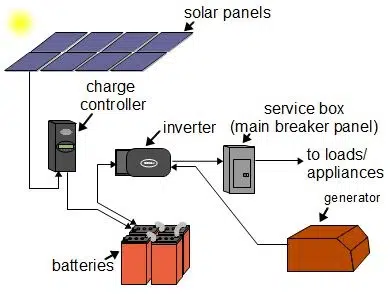An Overview to Powering Your Appliances With Solar Energy

We can divide our solar power setup into three main sections. These are (1) the battery/power supply, (2) the appliances we want to power that drain our batteries, and (3) the solar panels that recharge our batteries. Both our batteries and our panels can be wired in series or in parallel depending on our needs. Let’s break each one down, starting with our batteries:
Part One, The Power Supply
Amp/Hours, The Energy in Your System
The amount of energy contained in a given battery is measured using something called amp/hours. The same way we might say an apple has 95 calories, we can say a standard lead battery contains 100 amp/hours. This means that, in theory, we could drain 1 amp for 100 hours or 100 amps for one hour. In real world applications, that’s not the case. A standard battery might have a label that reads 100 AH(amp/hours) @ 20 HR(hours). This means that the battery is rated to supply 5 amps for 20 hours at a useful voltage.
It’s important that we understand that amp/hours is just a measure of total energy in the battery, so here’s another example: Car batteries typically contain only around 45 amp/hours of energy. When we crank our starters to turn on our engines, 100+ amps can be drawn from the battery. However, this high drain only lasts for as long as it takes to turn your engine over. As soon as your engine turns over, the car battery is quickly recharged from the car’s alternator.
You may ask yourself then, what battery should I buy? How many amp/hours will I need? What if my daily drain is greater than any one battery can provide?
Setting up Multiple Batteries in Parallel VS Series
For most applications, a single battery with 100 AH will not supply enough energy. To get more power, we could buy multiple batteries. That leads to the question: “How do I set up my multiple batteries? There are two ways, in Series or in Parallel. When batteries are wired in Series, the voltage is added. When batteries are wired in Parallel, the amp/hours are added. If we wire four 100 amp/hour batteries together in Parallel, our system will have 400 total amp/hours of energy at 12 volts. Most common battery setup will want to wire their batteries in Parallel, but it is possible to wire in parallel and series to achieve 24/48 volts. For most applications however, 12 volts is already a useful voltage.
To wire a battery in parallel, we use wires to connect each of the positive terminals of our batteries, then, using another wire, connect all the negative terminals of our batteries. This will increase our amp/hour storage while maintaining the same voltage.
To wire a battery in series, we wire the positive of one battery onto the negative of the next one, repeating this process for each battery in our setup. This adds up the voltage of our setup while the amp/hour storage remains the same.
Part Two, The Drain from Your Appliances
Powering Your Appliances Using an Inverter
Most solar setups incorporate inverters. Inverters convert the DC(direct current) from our batteries into AC(alternating current) that can be used by most household appliances like TVs or refrigerators.
Not all inverters are created equal, and you’ll need to make sure that the inverter you buy for your system can output enough watts for your setup. This article will only be going into the power supply needed to power your appliances.
How Long Will My Batteries Be Able to Power My Setup?
We describe the power drain that household appliances pull on your batteries using Watts. To simplify, Watts is a description of the rate of amp/hours drained by a given appliance. The amount of drain is different for each application, and is influenced by whether the appliance uses DC or AC.
So if the number of Watts an appliance requires describes how many amp/hours it will pull from our batteries while in use, how can we know how long our appliance will run with a given amp/hour battery setup then?
Here’s a formula from DonRowe.com that will tell us the number of hours a given battery supply will be able to run an inverter containing our appliances.
https://www.donrowe.com/power-inverter-faq-a/258.htm#how_long
We first add up our batteries’ total amp/hours. (Remember, this is information that you can find on the label of each battery.) In our example setup, we have four batteries wired in parallel which gives us 400 total amp/hours.
Now we need to decide what kind of appliances we want to power with this setup. Let’s say we want to power a TV which drains our amp/hours at a rate of 60 watts.
Here is the formula:
((10 X 400 Amp/Hours)/(60))/2) = around 33 hours of continuous TV usage if we start at full charge.
Another Example:
Let’s say we have the same four 100 amp/hour batteries wired in parallel, giving us 400 total amp/hours at 12 volts. What if we wanted to power our 60 watt TV, and an 80 watt refrigerator?
Ex:
(10 X 400 amp/hours)/(60 watts from TV+80 watts from Fridge)=(28/2)= around 14 hours of continuous use.
Of course, the point of our solar setup is to charge our batteries during the day while it’s sunny, so our amp/hours will be going up during the day instead of just getting drained by our appliances.
Part Three, Charging Our Batteries Using Solar Panels
Solar Panel Basics
Our solar recharging kit will have two main elements. The PANELS, which generate power from the sun, and the SOLAR CHARGE CONTROLLER, which converts this current into a voltage and amperage that can charge the battery without damaging it.
Solar Charge Controller
Most solar panels output a voltage that will damage your battery if connected directly. That’s why solar setups include Solar Charge Controllers. These devices limit the amount of voltage flowing from your panels into your batteries to prevent damage, reduce drain during the night, and to prevent overdraining from your appliances.
For example, a given solar panel may output 24 volts to your battery. With a standard 12 volt setup, no more than 14-14.5 volts would be necessary to fully charge your battery. Our solar charge controllers limit the flow of electricity to limit this damage.
There are two main kinds of charge controllers, MPPT and PWM charge controllers.
MPPT vs PWM
Both MPPT and PWM limit the voltage to your battery, but they do it in different ways.
Maximum Power Point Tracking(MPPT) charge controllers are the more expensive option. They convert the excess voltage into amperage, effectively increasing the charging rate of your battery. In our example above, an MPPT charge controller would limit our 24 volts coming from our solar panels but increase the current, so the total power flow remains about the same. Using an MPPT charge controller means you can deal with a higher overall voltage effectively, which has advantages that we’ll discuss in the Solar Panel section.
PWM controllers are cheaper, but lack this feature. In the example above, they’d also limit the voltage down to 12 volts, but they wouldn’t change the amperage. In effect, half of the generated power is lost! It’s highly recommended that you use a battery bank with a voltage matching the output of your solar panels if you use a PWM charge controller.
Wiring our Solar Panels
Just as we can wire our batteries in series or parallel, we can also wire our solar panels in series or parallel. Remember, when we wire in parallel, we add our amps. When we wire in series, we add our volts.
When charging batteries, we want our charging current to reach a certain level of volts, then increase our amperage to charge faster. A 12 volts and 3 amps charging current will charge much faster than a 12 volt and 1 amp current. So you may be tempted to always wire in parallel, especially with the knowledge that high watt solar panels already release more than 12 volts. We must be careful before we increase our amps in this way though. We have to think about our wires.
If we massively increase our amps, we’ll need extremely low gauge(thick) cables to safely carry this current. The more amps we put through our wires, the more heat they’ll generate as well. Low voltage currents will also have voltage loss if we’re carrying our energy for long distances.
This is why you may find having an MPPT charge controller may be worth the added cost. With an MPPT charge controller we can wire our panels in series, deal with an easy high voltage low amp current, and still lose almost no energy while charging our batteries.
How Many Panels Do I Need?
A common question we receive is this: “How many panels should I buy? How many watts will I need to produce to power my setup?”
Every setup is different. If you just want to charge your phone and laptop your setup will look different than someone who wants to power their fridge, TV, and several LED lights.
Here’s how you can get a rough estimate of how much energy your setup will need. Appliances use watts. You can google all the watt usage for each of your appliances, then multiply the number of hours you expect to use them per day and add them together. For example, we can use our tv and refrigerator example from earlier. We plan on using our 60 watt tv for 4 hours per day, resulting in 240 Watt/Hours drain (20 amp/hours). We want to run our 80 watt refrigerador 24 hours a day, resulting in a drain of 1920 Watt/Hours(160 amp/hours). This means that our system will have a drain of 2160 watt/hours per day.
So how many panels will we need? If we suppose that we have a single 500 watt panel and that we’ll have, on average, five hours of sunlight per day. That means we’ll be theoretically generating 2500 Watt/Hours per day. You may think that this will more than cover your uses, but it’s important to factor in power loss and inefficiencies.
If you want some help determining how many solar panels you need for your setup, try out this solar calculator. This will give you an estimate based on how many appliances you want to power.
It’s common to multiply your expected power generation by .85 to account for losses resulting from inefficiencies in the inverter, the charge controller, the natural battery loss of charge, wiring loss, and imperfect real-world panel performance. So our single 500 watt panel will probably produce something more like 425 watts per hour of sunlight. If we multiply this by our five hours of sunlight, that means we’re only going to be producing 2125 watt/hours of energy, less than our daily drain.
How Many Batteries Do I Need?
We never want lead deep cycle batteries to go below 50% charge to avoid damage. This means that we’ll need a battery setup that has an energy capacity of at least twice our drain. In our example above, we’d want at least 4500 watt hours(around 375 amp/hours). This means we’d want at least two lead acid batteries with 200 amp/hour ratings.
Conclusion
Solar energy setups are a complicated technology. With a little research and planning of your solar setup, with a large enough Battery/Power Supply, with a good idea of how much drain our Appliances will pull from our setup, and with an understanding of Solar Charge Controllers and Solar Panels, our setups will allow us to power our appliances anywhere in the world, on or off the grid.
You can see our selection of Solar Panels and Accessories over at https://www.santansolar.com/
